Writing abstracts-英文文章文献写作
- 格式:ppt
- 大小:2.19 MB
- 文档页数:45
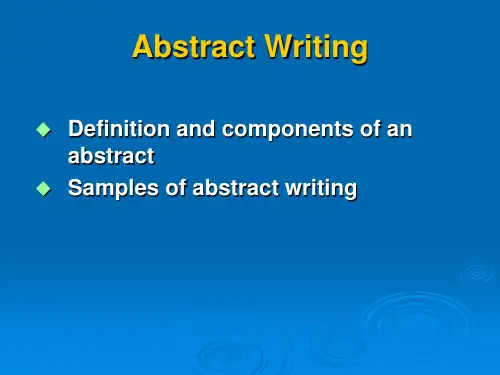
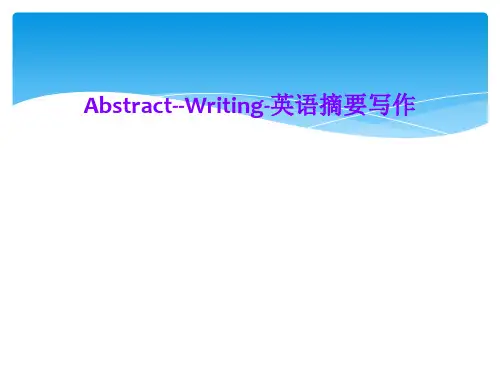
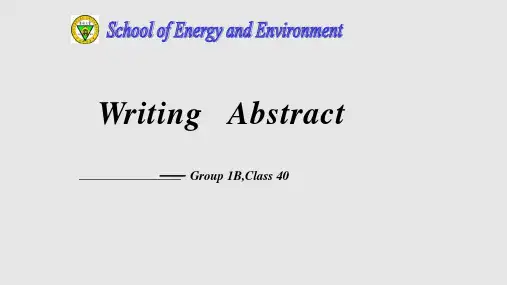
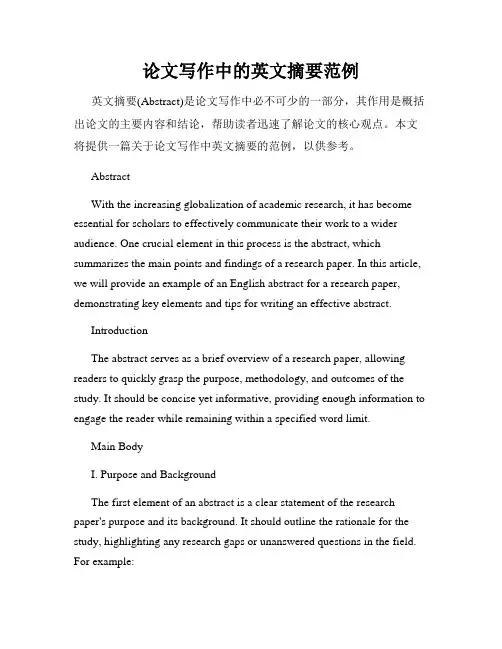
论文写作中的英文摘要范例英文摘要(Abstract)是论文写作中必不可少的一部分,其作用是概括出论文的主要内容和结论,帮助读者迅速了解论文的核心观点。
本文将提供一篇关于论文写作中英文摘要的范例,以供参考。
AbstractWith the increasing globalization of academic research, it has become essential for scholars to effectively communicate their work to a wider audience. One crucial element in this process is the abstract, which summarizes the main points and findings of a research paper. In this article, we will provide an example of an English abstract for a research paper, demonstrating key elements and tips for writing an effective abstract.IntroductionThe abstract serves as a brief overview of a research paper, allowing readers to quickly grasp the purpose, methodology, and outcomes of the study. It should be concise yet informative, providing enough information to engage the reader while remaining within a specified word limit.Main BodyI. Purpose and BackgroundThe first element of an abstract is a clear statement of the research paper's purpose and its background. It should outline the rationale for the study, highlighting any research gaps or unanswered questions in the field. For example:This research aims to investigate the effects of climate change on coastal ecosystems, with a focus on marine biodiversity and coral reef health. Given the increasing threats to these ecosystems, understanding the potential impacts of climate change is crucial for effective conservation strategies.II. MethodologyThe abstract should briefly describe the methodology employed in the research. This can include the study design, data collection methods, and analytical approaches. However, detailed technical information should be avoided. For example:A combination of field surveys, laboratory experiments, and statistical analyses were conducted to assess the long-term effects of temperature increase and ocean acidification on coral reefs. Data on species diversity, abundance, and health were collected from various reefs in the Caribbean region.III. ResultsThe abstract should highlight the key findings of the research. It should summarize the outcomes and conclusions derived from the data analysis. However, specific data or numerical results should be avoided, focusing instead on general trends and significant discoveries. For example:Our study revealed a significant decline in coral species diversity and overall health in response to increased water temperatures and ocean acidification. Furthermore, we found a decrease in the abundance of commercially important fish species, indicating potential impacts on local communities dependent on coral reef resources.IV. Implications and ConclusionThe abstract should conclude with a discussion of the broader implications of the research and its significance. It should provide a concise statement summarizing the main contributions of the study to the field and any recommendations for future research or policy implications. For example:These findings highlight the urgent need for immediate actions to mitigate the effects of climate change on coastal ecosystems. Implementing measures to reduce greenhouse gas emissions and establishing marine protected areas can help safeguard marine biodiversity and protect the livelihoods of communities dependent on coral reef resources.ConclusionIn conclusion, writing an effective English abstract is crucial for communicating the key points and contributions of a research paper. By providing a clear purpose, concise methodology, major findings, and broader implications, the abstract serves as a concise summary of the research work, enticing readers to delve deeper into the full paper. By following the guidelines and structure provided in this example abstract, researchers can enhance their chances of effectively conveying their research to a global audience.。

How to Write an Abstract for a Research PaperWANG YanSchool of International StudiesUIBEIssues to address:1What is an abstract?2Functions of an abstract3Structure of an abstract4Principles of abstract writing1. What is an abstract?☐An abstract is a condensed version of a longer piece of writing that highlights the major points covered, concisely describes the purpose and scope of the writing,and reviews the writing's contents inabbreviated form.⏹It is a concise and clear summary of acomplete research paper.⏹It tells the reader What you set out todo, and Why you did it,How you did it, What you found (recommendations).2. Functions of an abstract☐An abstract is used to communicate specific information from the article.☐It is aimed at introducing the subject to readers, who may then read the article to find out the author's results, conclusions, or recommendations.2. Functions of an abstract☐The practice of using key words in an abstract is vital because of today'selectronic information retrieval systems.⏹Titles and abstracts are filed electronically, andkey words are put in electronic storage.⏹When people search for information, they enterkey words related to the subject, and thecomputer prints out the titles of all the articlescontaining those key words.⏹An abstract must contain key words about whatis essential in an article so that someone elsecan retrieve information from it.3. Structure of an abstract☐The components of an abstract①Background Information②Subject Matter/Problem Statement③Purpose④Method (and Data)⑤Results / Findings⑥Conclusion / ImplicationsThe components of an abstract①Background information◆You may need to refer briefly to background toprovide a context.②Statement of the problem (subject matter):◆What problem(s) are you trying to solve?◆What is the author’s focus in this research?③Purpose of the research:◆What is the reason/purpose for doing this research?④Methods (approach and data):◆What is the main method used for the research?What is the theoretical framework?◆What is the subject scope? What data is analyzed?⑤Results (Findings):◆What did you find/invent/create?⑥Conclusion (Implications):◆What are the larger implications of your findings, esp.for the problem/gap identified in steps ①& ②?Exercise 1:A Sample Abstract(1) The dozens of studies on academic discourse carried out over the past 20 years have mostly focused on written academic prose or on academic lectures. (2) Other registers that may be more important for students adjusting to university life, such as textbooks, have received surprisingly little attention, and spoken registers such as study groups or on-campus service encounters have been virtually ignored. (3) To explain more fully the nature of the tasks that incoming international students encounter, this article undertakes a comprehensive linguistic description of the range of spoken and written registers at U.S. universities. (4) Specifically, the article describes a multidimensional analysis of register variation in the TOEFL 2000 Spoken and Written Academic Language Corpus. (5) The analysis shows that spoken registers are fundamentally different from written ones in university contexts, regardless of purpose. (6) Some of the register characterizations are particularly surprising. (7) The findings of this research may provide insights and have significant implications for pedagogy and further research.subject matter (1) The dozens of studies on academic discoursecarried out over the past 20 years have mostlyfocused on written academic prose or onacademic lectures.problem statement (2) Other registers that may be more important forstudents adjusting to university life, such astextbooks, have received surprisingly littleattention, and spoken registers such as studygroups or on-campus service encounters havebeen virtually ignored.background information(3) To explain more fully the nature of the tasks that incoming international students encounter, this article undertakes a comprehensive linguistic description of the range of spoken and written registers at U.S. universities.(4) Specifically, the article describes a multidimensional analysis of register variation in the TOEFL 2000 Spoken and Written Academic Language Corpus.purposemethod data(5) The analysis shows that spoken registers are fundamentally different from written ones in university contexts, regardless of purpose.(6) Some of the register characterizations are particularly surprising.(7) The findings of this research may provide insights and have significant implications for pedagogy and further research.findings implications Subject:written in the third person Length:short, usually 10% or less of the length of the original piece Audience:understandable to a wide audience Language:technical language of the discipline or profession Verbs:passive voice Tense:the present tense the past tense the present perfect tense 4. Principles of abstract writing4. Principles of abstract writing☐Requirements for the abstract of aBA thesis in UIBE⏹Length: 200-300 words⏹Key words: 3⏹One page of Chinese abstract and onepage of English abstractLanguage used in an abstract Background:(1) The dozens of studies on academicdiscourse carried out over the past 20years have mostly focused on writtenacademic prose or on academic lectures. (2) Other registers that may be moreimportant for students adjusting touniversity life, such as textbooks,have received surprisingly little attention, and spoken registers such as studygroups or on-campus service encountershave been virtually ignored.Language used in an abstract Background:☐Most studies in this field have addressed …☐In recent years, there has been an increasing interest in …☐… has received much attention in the field of …e.g.:As a newly developed interdisciplinary field of study, research on the development ofpragmatic competence is increasinglyattracting extensive academic interest.Purpose:(3) To explain more fully the nature of the tasks that incoming international students encounter, this article undertakes a comprehensive linguistic description ...This paperattempts to…The purpose of this paper is to …This paper isintended to…Language used in an abstract Language used in an abstract Purpose ☐The purpose/aim/objective/goal (of present study is/was to ☐The present study is /was designed/ devised/ intended to / aimed at ☐This study was performed/ conducted/ carried out/undertaken to ☐We aimed/sought to/attempted to e.g.:The aim of this study was to determine the protective function of …Methods:(4) Specifically, the article describes a multidimensional analysis of register variation...A …approach isused in this studyto examine.The study employsa … approach.Language used in an abstractMethods:☐Introduce the research process:⏹study, investigate, examine, discuss, analyze, emphasize, focus, explain☐Describe the research methods:⏹measure, estimate, calculate, test☐Introduce the uses or implications:⏹use, applyLanguage used in an abstract Results:(5) The analysis shows that spoken registers are fundamentally different from …(6) Some of the register characterizations are particularly surprising.It is found that …The resultsindicated that…The resultssuggest/show that …Language used in an abstract Results:☐Show the research results:⏹show, result, present, suggeste.g.:⏹Our results show that …⏹The results we obtained demonstrate that …⏹By means of informal mathematical arguments, simulations and a series of worked examples, we conclude that …Language used in an abstractConclusion/implications:(7) The findings of this research may provide insights and have significant implications for pedagogy and further research.It is suggested that …The paper suggests …It isrecommended that …It is concluded that …Language used in an abstract Conclusion/Implications:1) indicate the results:⏹These results suggest that …⏹These data confirm the presence of …2) support a point:⏹These results (do not) support the idea that …⏹These results fail to support the idea that …3) show uncertainty of an idea:⏹There is no evidence that …⏹It is likely/unlikely that …4) show significance of the findings:⏹be of great (some/little/no) clinical significance in …⏹It sheds light on future studies in this field.5) suggest further studies:⏹… remain to be further studied.⏹It remains to be proved that …Language used in an abstract Steps For Writing Effective Abstracts1.Reread your paper with the purpose of abstracting in mind. Look specifically for these main parts: purpose, methods, scope, results, conclusions, and recommendations.2.After you have finished rereading your paper, write a rough draft WITHOUT LOOKING BACK AT YOUR PAPER. Consider the main parts of the abstract listed in step 1. Do not merely copy key sentences from your paper.3.Revise your rough draft to correct weaknesses in organization and coherence, drop superfluous information, add important information originally left out, eliminate wordiness, and correct errors in grammar and mechanics.4.Carefully proofread your final copy.Four C's of Abstract Writing☐Complete—it covers the major parts of the project/case.☐Concise—it contains no excess wordiness or unnecessary information.☐Clear—it is readable, well organized, and not too jargon-laden.☐Cohesive—it flows smoothly between the parts.Qualities Of A Good AbstractAn effective abstract☐uses one or more well-developed paragraphs, which are unified, coherent, concise, and able tostand alone☐uses an introduction-body-conclusion structure in which the parts of the paper are discussed in order: purpose, methods, findings, conclusions☐follows strictly the chronology of the paper☐provides logical connections between materials included☐adds no new information but simply summarizes the research☐is intelligible to a wide audienceQualities Of A Good Abstract☐Accuracy —choose exact words for precise☐Specificity —be concrete☐Objectivity —succinctly summarize main points;☐Informativeness —what the research is about; how it was taken, what wasdiscovered☐Independency —must stand aloneSummary☐Writing an abstract is a sophisticated skill.To write a good abstract for your papersyou should follow a checklist consisting of: background, problem statement,purpose,method,results,and conclusion.☐Make sure that all the components of a good abstract are included in your paper.Summary☐The two main features of an abstract are its discourse structure and the language used for condensing the information.☐The secret of writing a successful abstract is in giving the most information in the leastnumber of words in a coherent structure.☐Because Readers want quick information.If it suits them, they will read on for thedetails.Exercise 2:☐Read the following abstract and find out the problems in terms ofstructure and language☐Revise the abstractDevelopmental changes in speakingvocabulary by English majorsI carried out a longitudinal study on the changes in speakingvocabulary by English majors through four years’learning, whichwas then compared with the native speakers’performance. TheEnglish learners involved in the study were 56 students who wereenrolled in a university in 2001. I asked them to complete an oraltask by producing a three-minute monologue after three minutes’preparation in a language lab. The native speakers were 15American college students who accomplished the same task asthe English learners. The developmental changes were measuredin terms of three indexes: fluency, word variations and lexicalfrequency profile. The performance on the three indexes of theEnglish majors across four years and the native speakers form acontinuum. However, Year Four students were significantly lowerin fluency and word variations than native speakers, but similar tothe native speakers in lexical frequency profile. The periodbetween Year Two and Year Three saw the most noticeableprogress. The students with different starting levels of the threeindexes varied in terms of their changes. The low-level groupmade greater progress than the middle-level group whichproduced slightly faster progress than the high-level group.Exercise 3:☐Read the selected abstracts fromsome published journal articles.☐Discuss the structure, content andlanguage of these abstracts.☐Make comments on these articles:⏹Are they well written?⏹If not, can you revise them?Assignment☐Write an abstract for your BAgraduation thesis11。
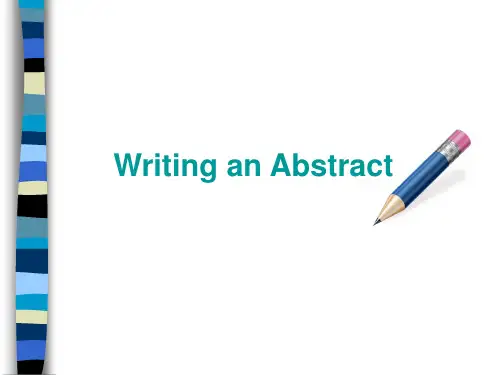
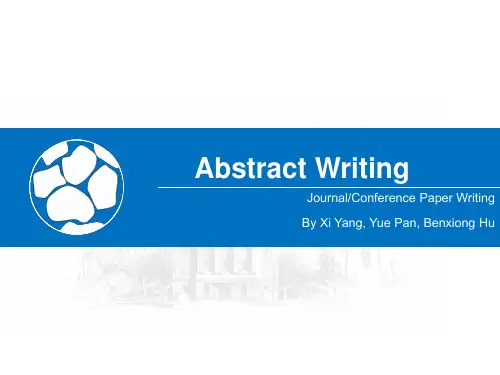

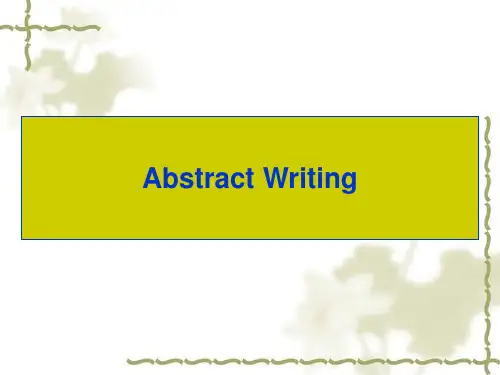
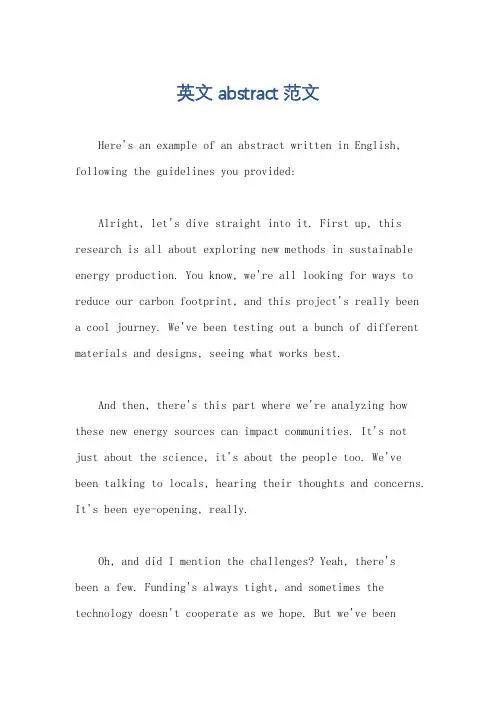
英文abstract范文Here's an example of an abstract written in English, following the guidelines you provided:Alright, let's dive straight into it. First up, this research is all about exploring new methods in sustainable energy production. You know, we're all looking for ways to reduce our carbon footprint, and this project's really been a cool journey. We've been testing out a bunch of different materials and designs, seeing what works best.And then, there's this part where we're analyzing how these new energy sources can impact communities. It's not just about the science, it's about the people too. We've been talking to locals, hearing their thoughts and concerns. It's been eye-opening, really.Oh, and did I mention the challenges? Yeah, there'sbeen a few. Funding's always tight, and sometimes the technology doesn't cooperate as we hope. But we've beenrolling with the punches, finding solutions and moving forward.Now, about the results. Well, let's just say we're excited! Some of our prototypes are showing real promise. They're not perfect yet, but we're getting closer and closer to our goals. It'。

论文季Howtowriteanabstract如何写英文摘要Write an Abstract如何写英文摘要春暖花开,又到了写论文的季节。
没有时间踏青?还在为论文苦恼?本期我们就一起来学习一下如何写英文摘要吧!在这个春天,我们一起做灿烂的学术宅什么是摘要 What is an abstract?An abstract is a concise summary of a research paper or entire thesis.摘要是以提供文献内容梗概为目的,不加评论和补充解释,简明、确切地记述文献重要内容的短文。
为什么要写摘要 Why write an abstract?Selection: Abstracts allow readers who may beinterested in the paper to quickly decide whether it is relevant to their purposes and whether they need to read the whole paper.Indexing: Most academic journal databases accessed through the library enable you to search abstracts. This allows for quick retrieval by users. Abstracts must incorporate the key terms that a potential researcher would use to search.允许读者进行快速筛选,检索,通过题目,关键词等方法判断他们是否需要阅读整篇文章。
What to include in an abstract1Reasons for WritingThe importance of the research and why would readers be interested in this large work?首先,摘要中应该包含本篇论文的重要性,言简意赅阐述清楚写作目的。
Writing: AbstractWHAT IS AN ABSTRACT1. The Definition of an Abstract1 ) the objectives and scope of investigation;2) the methods used;3) the most important results;4) conclusion or recommendation.2. Features of AbstractsBrevity Accuracy Specificity Objectivity Informativeness IndependencyCLASSIFICATION OF ABSTRACTS1.Indicative Abstractsrmative Abstractsrmative-indicative Abstracts4.Other Types of Abstracts 1) Critical Abstracts 2) Mini-abstractsFUNCTIONS OF ABSTRACTSA Screening Device of Documents: An abstract gives readers the idea of what the article is about.A Self-contained Text: We’ll know the information it contains, without seeing the article .A Helpful Preview: It "frames" the article and prepares the reader for the main points to come.To Facilitate Indexing: It will improve the chances of having it read by the right people.STYLISTIC FEATURES OF ABSTRACTS1. The Length of Abstracts1) In general, there is a 100-300 word limit to the number of words in an abstract.2) Do not confuse an abstract with a review. There should be no comment or evaluation.3) Give information only once.4) Do not repeat the information given in the title.5) Do not include any facts or ideas that are not in the text.6) For informative abstracts, include enough data to support the conclusions.7) If reference to procedure is essential, try to restrict it to identification of method or process.8) State results, conclusions, or findings in clear concise fashion.9) Organize the information in the way that is most useful to the reader. (a thesis-first abstract)2. Verbs and Tenses Used in Abstracts1) Active verbs: use active verbs rather than passive verbs.2) Present tense: background information, existing facts, what is in the paper and conclusion.3) Past tense /present perfect tense: completed research, methodology or major activities results.3. Words Used in Abstracts1) Avoid use of highly specialized words or abbreviations. Define unfamiliar words.2) Synthesize or rephrase the information into clear, concise statements.3) Avoid using jargon.4. Sentence Structures of Abstracts1) Use third person sentences.2) Use short sentences, but vary sentence structure.3) Use complete sentences.4) The first sentence should present the subject and scope of the report. The thesis or the writer's focus should be presented in the second sentence. The balance of the article is a summary of the important points of each section, including methods, procedures, results and conclusions.5) Good abstracts are sure to include a variety of pat phrases:a. Background Information (Research has shown... It has been proposed... Another proposed property... The search is on for... One of the promising new...)b. Statement of the Problem (The objective of the research is to prove / verify... The experiment was designed to determine...)e. Statement of Procedure (To investigate this .... A group of 10 specimens / subjects ... Measurementswere taken after... A second group was...)d. Conclusions (It was found that .... Results imply... This data suggests... In the experimental group... In the control group...)e. Relates the Experiment to the Words (This kind of research encourages the belief that... Similar to ...) HOW TO WRITE AN ABSTRACT (An abstract must be written last as it sums up the results)l) Locate the thesis statement, identify the main divisions of the document, find the main terms (key words) and statements in each section;2) Decide the degree of detail to include;3) Prepare a single paragraph including the crucial information gathered;4) Edit the draft, eliminate unnecessary background information, and reduce wordy phrases;5) Finally, revise the opening statement to emphasize the new information contained in the paper.Start out the abstract by telling exactly what you did and how you did it. Focus on the rationale and ideas of the study and why it is important in the first two sentences. In the next few lines, focus on the materials and methods, and the data generated from the study. Tell the reader how the data were collected, compiled, and state statistical significance(s). Mention any new tools developed.Avoid using bibliographic references in the abstract. However, if your article follows directly from a published work and is a major advance on that specific piece of work, do cite the paper in the abstract.The end of the abstract is just as important as the beginning. The concluding lines of the abstract should lead into the first paragraph of the introduction without repeating what has been said. State the implications of your studies to the field of scholarship in which you are working.1. How to Write Informative Abstracts1) An informative abstract should be orderly, succinct, and concrete, with the length of no mere than 10% of the essay.2) Plan to write an abstract that is in the first draft, note key facts, statistics, etc. on the organisms, materials and locations used.3) Do not include a statement of scope or a sentence like "this paper will look at .... ".4) Write selected details of the experimental methods, including the duration of the study, the treatments, methods and equipment used.5) Be sure to omit or condense lengthy examples, tables, and other supporting detail.6) Do not hedge or equivocate.7) Give the key results, with a description of them and some of the main figures and their statistical significance.8) Use active verbs such as "report", "propos ", and "analyze" rather than static verbs such as "is", "are" and "appears to be".9) Revise the draft into smooth, stand-alone prose; the abstract itself should be a mini-essay.10) Edit the revision. Be sure that the abstract is complete and accurate, with a brief note on the significance of the results.11) Double check that the abstract is written in the same voice as is the paper.2. How to Write Indicative Abstracts1) List the title of the research report after "Abstract of..." at the top of your page.2) Summarize the major thesis and supporting main ideas of the report without omitting any important ideas.3) Avoid wordiness and repetition.4) Condense source material in your own words, being careful not to directly borrow text. You should not use direct quotations in abstracts.5) Use good sentence structure, grammar, mechanics, and spelling.6) Adhere to the 100-word limit. (No fewer than 90, nor more than 110)3. How to write Abstracts for Engineering InformationBackground: A simple opening sentence or two ;Aims: One or two sentences giving the purpose, the development, the survey as well as the assignment and the scope of the research;Method(s): One or two sentences explaining what was done and what the principles, the theory, the condition, the objective, the techniques, the framework, the means, the equipment and the procedure, etc. used in the research are;Results: One or two sentences indicating the main findings, the result, the data, the relationship, the effect and the performance of the experiment and research;Conclusions: One sentence giving the most important consequence of the work, the results of the analysis, the research, the evaluation and the application, and the issues that are raised as well.4. How to Write Abstracts for DissertationsThere are two purposes in dissertation abstract writing: to inform your reader, and to market your product. Aside from the guidelines mentioned above, there are some others:1) a dissertation abstract should have three elements, and three elements alone:a. a section on the problem you examined;b. a section showing your method;c. a section showing your findings.2) you need not give the history of the problem, why you chose to study it, your philosophy, or your self-congratulatory but humble remarks about how your dissertation will change the world.3) be sure to use some key words for easy referencing, an accurate and specific summary of your findings, and as active a voice as you can muster.5. How to Write Abstracts for ConferencesIt is a competitive process, but one to be undertaken seriously.1) Look for "Call for Papers" notices.2) Title: The title should be informative and focused, indicating the problem, kind of data and your general approach.3) Make your abstract as brief as possible, within the word limit set by the "Call for Papers".4) Make sure to describe the general topic clearly.5) Try to make your abstract appeal to the concept for the conference as it is defined in the "Call for Papers".6) Describe your treatment of the topic, and how it relates to previous work on the same topic.7) Explain how you will justify your treatment, and quote crucial evidence.8) Consider your audience carefully. You are essentially writing a speech. Your sentence structures, use of specialized language and theories, etc., should take this into account. Also, in oral discourse, you might want to summarize and / or repeat ideas more often.6. How to Write Research Abstracts1)The purpose of a research abstract can be boiled down to providing the answers to the following questions:a. Why did you start?b. What did you do?c. What did you find?d. What does it mean?2) Title: Ideally about 10-12 words long, the title should include the scope of the investigation, the study design, and the goal. In general it is preferable to make the title a description of what was investigated. The title should be easy for the reader to understand and should not include jargon or 3) Introduction or Background: this should provide a brief context or explanation for doing the study, and state the aim of the study, and ideally should include a concise statement of the study' s hypothesis. A scientific study is "to find out whether it is true."4) Methods: In an abstract the description of the methods has to be concise, and much of the details of what was done must be omitted. However, in a few short sentences the reader can be given a good idea of the design of the study, the context in which it was done, and the types of patients or measurements that were included.5) Results: space is limited. Still, it is important to give the main results of the study not just in subjective terms but also in the form of the most important data. Do not include a table or figure unless it is necessary to convey your results.6) Conclusions: Keep your conclusions reasonable and supportable by the findings of your study.7) Follow the instructions7. Some Don'ts in Abstract Writing1) Do not commence with "this paper...", "this report..." or similar. It is better to write about the research. Similarly, do not explain the sections or parts of the paper.2) Avoid sentences that end in "... is described", "... is reported", "... is analyzed" or similar. These are simply too vague to be informative.3) Do not begin sentences with "it is suggested that...", "it is believed that... ", "it is felt that..." or similar, for the words can be omitted without damaging the essential message.4) Do not write in the first person. Not only should you avoid I, but also we , the author , the writer, etc., because the abstract should be about the research, not about the act of writing.5) Do not submit an abstract with the length exceeding the limit offered.6) Do not submit your abstract later than the given date.7) Do not write an imprecise abstract.SAMPLESSample 1:Microscopic characterization of a TiB2-carbon material composite:Raw materials and composite characterizationAbstract: Titanium diboride (TiB2) is a very attractive material for the aluminum industry, because it is readily wetted by molten aluminum and combines good physical properties (electrical conductivity), chemical (fairly resistant to dissolution by molten aluminum), and mechanical (wear resistance) properties.// In this article, both raw materials(anthracite, pitch, and TiB2powder) and TiB2-carbon composites (TCC) were characterized.//Inclusions of aluminosilicate and iron oxide types were found in the anthracity aggregates. X-ray diffraction (XRD) analysis allowed differentiation between two types of aggregates: stratified (L C=44 nm) and nonstratified (L C=15 nm). The principal impurity found in the TiB2 powder was TiCN and surface analysis of the particles revealed the presence of a contaminant layer composed of C, N, O, and Ti; the thickness of this layer varied from 5 to 15 nm.// Characterization of the TiB2particles in the composite showed important surface modifications compared to their initial state. Evidence seen on the particles’ surfaces showed that a TiC-(O traces) formed preferentially on the side of particles rather than on top surface. The thickness of this TiC-(O traces) layer was evaluated to 30 nm.TiB2碳基复合材料的微观特征:原材料和复合物特征硼化钛(TiB2)在制铝业中是一种很受欢迎的材料,由于它易于被熔融的铝润湿,而且具有好的物理性能(导电率),化学性能(很好地抵御被熔融的铝分解)和机械性能(耐磨性).在这篇文章中,讨论了原材料(无烟煤,沥青和TiB2粉末)及TiB2碳基复合材料(TCC)的特征.在无沿煤聚合体中发现了铝矽酸盐和铁的氧化物.由X 射线衍射分析(XRD)可得两种聚合物的区别:层积的(L C=44 nm)和未层积的(L C=15 nm). TiB2粉末中发现的主要杂质是TiCN,另外颗粒表面分析可见由C, N, O, 和Ti组成的污染层;这个污染层从长远来5直15 nm 不等.符合物中TiB2颗粒的特征表明了与初始状态相比而言很重要的表面修正.颗粒表面所见的迹象显示TiC-(O traces)优先在颗粒的边缘而不是顶表面形成.这个TiC-(O traces)层厚度据估计有30 nm.Sample 2:Establishing a knowledge management programme for competitive advantage in an enterprise Abstract: This article is concerned with the establishment of a knowledge management programme that will ensure sustainable competitive advantage within an enterprise//. The main problem under investigation is to assess the importance of knowledge management within an enterprise and to ascertain how it can ensure sustained competitive advantage in an enterprise.// An empirical survey was conducted in the Eskom Transmission Group, Johannesburg, South Africa to investigate understanding of the knowledge management concept amongst business leader, determine enablers and barriers to implement a knowledge management programme and to determine whether knowledge is seen as a source for competitive advantage.// It is suggested that enterprises should adopt a holistic and integrated approach when establishing such a programme. Broad recommendations for establishing a knowledge management programme that will be source of sustainable competitive advantage are proposed. 2001 Elsevier Science Ltd.为实现企业的竞争优势建立知识管理的程序这是一篇关于为确保企业持续性竞争优势建立知识管理程序的文章.调查的主要问题是评价企业中知识管理的重要性和确定知识管理怎样保证企业的持续性竞争优势.为了调查知识管理概念在商业领导者中的理解程度,确定实施知识经济管理程序的有利和不利因素以及确定是否知识被看作竞争优势的源泉,南美约翰内斯堡的埃斯克姆传播小组进行了一次实验性研究.文章建议在建立知识管理程序的时候,企业应该采用完整综合的方法.文章在作为持续性竞争优势源泉的知识管理程序的建立方面提出了狠多的建议.。
英文文章摘要范文An abstract is a concise summary of a research paper, thesis, review, conference proceeding, or any in-depth analysis of a particular subject and is often used to help the reader quickly ascertain the paper's purpose. Abstracts highlight the main ideas and core information outlined in a longer piece of writing. They allow readers to survey the contents of a paper and decide whether it is relevant to their own research or interests. A well-crafted abstract can determine whether an audience will want to read the entire work.When writing an abstract, it is important to include the essential elements that will provide the reader with a clear, concise understanding of the paper's content. These key components typically include the paper's purpose, methods, results, and conclusions. The abstract should accurately represent what is discussed in the greater body of the work without including too much extraneous information.The first sentence of an abstract should clearly introduce the topic of the paper and provide some background information. This openingstatement should concisely explain the significance or importance of the research. For example, an abstract for a paper on a new treatment for cancer might begin by stating, "This study examines the efficacy of a newly developed chemotherapy drug in treating late-stage lung cancer."Following the introductory sentence, the abstract should describe the methods or methodology used in the research. This section might cover the types of data collected, the research participants, the procedures followed, and the analytical techniques employed. Using the previous example, the methods section of the abstract could read, "A randomized, double-blind clinical trial was conducted with 500 participants diagnosed with stage 4 non-small cell lung cancer. Participants were randomly assigned to receive either the new chemotherapy drug or a placebo. Tumor size and progression were measured at regular intervals over the course of a 6-month treatment period."The results section of an abstract is critical, as it informs the reader of the key findings of the research. This part of the abstract should summarize the most important outcomes, trends, and conclusions supported by the data. In the lung cancer study example, the results might be stated as, "The results of the study showed that patients receiving the new chemotherapy drug experienced a 35% reduction in tumor size on average, compared to a 5% reduction in the placebogroup. Progression-free survival was also significantly higher in the treatment group."Finally, the abstract should conclude with a statement about the significance or implications of the research. This closing sentence or two should explain why the findings are important and what they contribute to the existing knowledge on the topic. Using the sample topic again, the concluding sentence of the abstract could read, "These findings suggest that this new chemotherapy drug could be an effective treatment option for patients with late-stage lung cancer who have exhausted other therapeutic avenues."When writing an abstract, it is essential to be as clear and concise as possible. Avoid jargon and overly technical language that may confuse or alienate the reader. The abstract should be self-contained, meaning it can be understood independently without the reader having to refer to the full paper. It is also important to accurately reflect the content and conclusions of the entire work - the abstract should not exaggerate or misrepresent the research.The length of an abstract can vary depending on the publication or assignment guidelines, but they are typically between 150 and 300 words. Some abstracts may be even shorter, ranging from a single paragraph to a maximum of 500 words. Regardless of the specific word count, the abstract should be tightly focused and provide acomprehensive overview of the key elements of the paper.In addition to succinctly summarizing the research, a well-written abstract can also serve other important functions. It allows researchers to quickly determine the relevance of a paper to their own work and decide whether they want to read the full text. Abstracts are also important for indexing and cataloging research, as they help make papers searchable and discoverable in databases and online repositories.Overall, the abstract is a critical component of a research paper or other academic work. It gives readers an at-a-glance understanding of the study's purpose, methods, findings, and significance. By following best practices for abstract writing, authors can ensure that their work is accessible, informative, and appealing to a wide audience of scholars and researchers.。